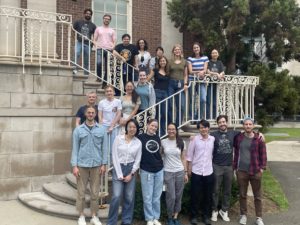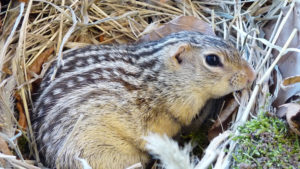
Stories

Elena Gracheva: Learning from Animal Adaptations
The moment Elena Gracheva stepped into the lab of Nobel Laureate David Julius, she knew she was in for a ride. “When David saw me, he told me I would be a good candidate to work with snakes,” she says. Having no previous experience with snakes, she was intrigued. “I took it as a compliment.”
At the time, Gracheva was working toward establishing herself as a neuroscientist and biochemist. After earning a master’s degree at Moscow State University, she attended the University of Illinois Chicago as a Ph.D. student studying neurotransmitters in the roundworm, C. elegans. Her next steps set her on a path that would lead to discoveries about the nature of exceptional animal adaptations and behaviors, with potential implications for human health. “For my postdoc, I wanted to do something really different, something outside the box,” she says.
That ambition brought her to the Julius lab at the University of California, San Francisco, which was researching the receptors involved in temperature and touch. Gracheva began investigating an unusual feature of the sensory system of snakes. “Some snakes have the ability to see prey without eyes,” she says. This ability is owed to their unique pit organs, which allow them to detect infrared radiation from heat sources in their environment, including other animals’ body heat.
At the time, no one understood the genetic underpinning of this superpower. Gracheva’s tenure in the Julius lab coincided with the dawn of RNA sequencing techniques, and with her colleagues, she embarked on the first differential gene-expression study of infrared sensing in vipers, pythons, and boas. She and her colleagues traveled to the National Natural Toxins Research Center in Kingsville, Texas, to collect nerve cells from these snakes.
“Kingsville is a very small town. They have just one shop there—Walmart—but they have dry ice, and they also have FedEx,” she says. “So we dissected ganglia, put them in dry ice, and sent them overnight to UCSF.” That research led to the discovery of the transient receptor potential (TRP) A1 ion channels as the thermal sensor in pit-bearing snakes, published in 2010 in Nature.
After her postdoctoral training, Gracheva was determined to start her own lab where she could explore other mechanisms related to temperature sensing and regulation in animals. She drew inspiration from a childhood interest. “Back when I was a kid in Russia, hibernation was always on my radar,” she says. “I learned about species that can hibernate through kids’ books and magazines.” During hibernation, a mammalian core body temperature can drop from 37 degrees Celsius to around 2 to 10 degrees Celsius for months. Gracheva was particularly interested in how these mammals manage such extreme adaptation.
After deciding to make Yale University her home in 2012, Gracheva was selected as a Rita Allen Foundation Scholar during her first year as an assistant professor. “That was the first funding I got after the faculty startup package,” she says. “It gave me a lot of freedom to pursue the project. It was also very motivational for my trainees to know that the Foundation appreciates the science they do.”

For the first three years, Gracheva’s lab studied hibernation in thirteen-lined ground squirrels (Ictidomys tridecemlineatus). Some animals hibernate in response to a trigger, such as cold or a reduction in food availability. But these ground squirrels are obligate hibernators, meaning they go into hibernation every year, regardless of the temperature. This makes them appealing research subjects, Gracheva says. “Ground squirrels have the ability to hibernate no matter the season.”
In 2017, Gracheva and her team discovered an ion channel, TRPM8, in the neurons of ground squirrels that helps these rodents resist cold. The study, published in Cell Reports, received attention from numerous media outlets, including the New York Times.
While non-hibernating rodents such as mice and rats also have TRPM8, the researchers found that the activity of the ion channel is much more difficult to activate in hibernating rodents like ground squirrels and Syrian hamsters, thanks to mutations in six amino acids. When the environmental temperature drops below 20 degrees Celsius, the neurons in the peripheral sensory system of non-hibernators like mice and humans start firing in response to the cold. “But in the case of the hibernators, we found that the neurons don’t care if it’s 20 degrees, 15 degrees, or 10 degrees,” Gracheva says. “They only start firing when the temperature drops below 5 degrees Celsius, which is the temperature in your refrigerator.”
Interestingly, when the scientists substituted the TRPM8 amino acids in mice, they could make the animals insensitive to cold. “From a pharmacological standpoint, we can use this knowledge to find targets in humans who are intolerant to cold,” Gracheva says. Hypersensitivity to cold may be linked to disorders such as Raynaud’s disease, where cold causes the blood vessels in fingers, toes, or other extremities to constrict, dramatically reducing blood flow to those areas.
Since its founding, the Gracheva lab has grown its ground squirrel population from 46 to more than 500. Receiving funding early on from the Rita Allen Foundation Scholars program enabled Gracheva to secure two additional grants from the National Institutes of Health and the National Science Foundation. “Rita Allen allowed us to get the preliminary results, publish my first paper on the topic, and establish a proof of principle that we can do it,” Gracheva says.

The Gracheva lab continues to expand our knowledge of mammalian hibernation. Last year, they published a study in Nature Communications describing ground squirrels’ ability to suppress hunger for five to seven months by inhibiting activation of the hypothalamic feeding center by the appetite hormones, ghrelin and leptin. “Even if you wake these squirrels up in the middle of hibernation and give them food, they are not going to eat,” Gracheva says. This ability is called self-induced anorexia, which in humans is a devastating disease. “That opens a new avenue for research in my lab. Now we’re looking at metabolic changes, hunger, satiety regulation at the molecular, cellular, and circuitry levels with the idea that in the future this may be very important for clinicians to treat physiological anorexia in humans.”
In a separate study last year in Science, the lab also unlocked the mechanisms that help these squirrels allay thirst. “This study can potentially help us identify very important regions in the brain that we can tweak to prevent dehydration when needed,” Gracheva says. “For example, during a space journey.”
Gracheva recently shared a few tips for those beginning their scientific careers and considering applying for the Rita Allen award:
What is your advice for early career scientists who are starting their own lab?
I think that curiosity is the most important part of our scientific journey. And if you’re losing curiosity, maybe it’s time to move to a different scientific project. If you start something new and exciting, you will make mistakes—this is inevitable. But you will fix these mistakes, so don’t be afraid to start something new. I think this is very important.
You also need to be a good citizen in your department, and your university, and with your trainees. This actually helps you to do good science. Everything has to be mutually beneficial.
What would you say to people who are considering applying for a Rita Allen Foundation Scholars Award?
First of all, if you don’t apply, you don’t get it. Secondly, with a foundation like Rita Allen, you have to think outside of the box. You have to be very creative. You don’t need to have a lot of preliminary data, but you have to be creative and curious. I still interact with quite a few scientists that I met at the Rita Allen meetings, and they’re doing very exciting outside-of-the-box science.
How has being part of the community of Rita Allen Foundation Scholars benefited your research?
We’ve stayed connected, and I’ve invited some of the Rita Allen trainees to give talks here at Yale, and vice versa. You create these connections for the rest of your life, even if you don’t think that you overlap scientifically. Some of the inspiration for projects in the lab I got from other trainees at the Scholars meetings. I think this is the most exciting part, because if I go to a meeting of hibernation scientists, I don’t think that I will discover something completely new. But if you go to meetings where you have different varieties of expertise, you can get completely different perspectives on your own topic. And you also can give advice to your colleagues on topics that they’re working on. That’s the beauty of being a part of Rita Allen Foundation community.